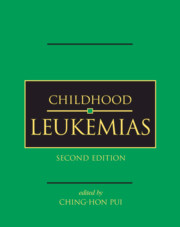Book contents
- Frontmatter
- Contents
- List of contributors
- Preface
- Part I History and general issues
- Part II Cell biology and pathobiology
- 4 Anatomy and physiology of hematopoiesis
- 5 Hematopoietic growth factors
- 6 Signal transduction in the regulation of hematopoiesis
- 7 Immunophenotyping
- 8 Immunoglobulin and T-cell receptor gene rearrangements
- 9 Cytogenetics of acute leukemias
- 10 Molecular genetics of acute lymphoblastic leukemia
- 11 Molecular genetics of acute myeloid leukemia
- 12 Apoptosis and chemoresistance
- 13 Heritable predispositions to childhood hematologic malignancies
- Part III Evaluation and treatment
- Part IV Complications and supportive care
- Index
- Plate Section between pages 400 and 401
- References
13 - Heritable predispositions to childhood hematologic malignancies
from Part II - Cell biology and pathobiology
Published online by Cambridge University Press: 01 July 2010
- Frontmatter
- Contents
- List of contributors
- Preface
- Part I History and general issues
- Part II Cell biology and pathobiology
- 4 Anatomy and physiology of hematopoiesis
- 5 Hematopoietic growth factors
- 6 Signal transduction in the regulation of hematopoiesis
- 7 Immunophenotyping
- 8 Immunoglobulin and T-cell receptor gene rearrangements
- 9 Cytogenetics of acute leukemias
- 10 Molecular genetics of acute lymphoblastic leukemia
- 11 Molecular genetics of acute myeloid leukemia
- 12 Apoptosis and chemoresistance
- 13 Heritable predispositions to childhood hematologic malignancies
- Part III Evaluation and treatment
- Part IV Complications and supportive care
- Index
- Plate Section between pages 400 and 401
- References
Summary
Introduction
Inherited cancer syndromes were estimated to account for only 0.1% of all malignant neoplasms in 1990; however, a known genetic predisposition was observed in 4.2% of pediatric cases. As new genes and more complex patterns of inheritance and penetrance have been uncovered, the proportion of both childhood and adult cancers arising in patients with a known constitutional susceptibility has continued to rise. A survey performed by Draper and associates identified four clinical syndromes that accounted for approximately 90% of children who developed cancer in the context of an inherited predisposition. Two of these – familial Wilms tumor and retinoblastoma – are caused by high-penetrance germline mutations that are rare in the general population. By contrast, neurofibromatosis type 1 (NF1) and Down syndrome are common genetic disorders that are associated with a much lower overall risk of cancer. However, because each conditon is readily diagnosed on the basis of a constellation of clinical features, the elevated incidence of cancer relative to the general population is readily apparent.
Although uncommon, familial cancer syndromes have been extraordinarily informative for defining general mechanisms of tumorigenesis and for discovering the responsible genes. In addition, many of the genes that confer a genetic predisposition to childhood cancer play a central role in normal cellular growth control. Furthermore, because most human cancers carry multiple cooperating mutations, uncovering genetic lesions that are capable of initating tumorigenesis in vivo can be problematic.
- Type
- Chapter
- Information
- Childhood Leukemias , pp. 362 - 388Publisher: Cambridge University PressPrint publication year: 2006
References
- 2
- Cited by



